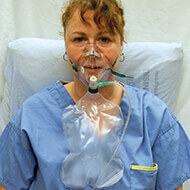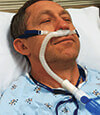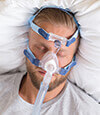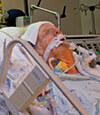
- Audio for Breathing Support for Respiratory Failure
For a variety of reasons, some patients with sepsis will need assistance with breathing. Sometimes it is because of a lung infection. Other times, it is because of excess fluid in the lungs. There are a variety of devices and machines that are used in the ICU to help with breathing.



Nasal Cannula, Face Mask, Venturi Mask and Non-rebreather Mask
A nasal cannula is a simple tube that directs oxygen into the nose. This is the least amount of breathing support that a patient can use.
Oxygen can be delivered with a face mask. The Venturi mask (also called a Venti mask) is a special kind of face mask that allows for more adjustment of the amount of oxygen delivered. A non-rebreather mask has a bag on one end and is used to deliver 100% oxygen.

High-Flow Nasal Cannula
A high-flow nasal cannula (HFNC) is an oxygen delivery device that can provide heated and humidified oxygen at high flow rates. HFNC can deliver up to 100% oxygen at a flow rate of up to 60 liters per minute. Patients on HFNC may be able to talk and eat while continuing to receive the oxygen support they need.

Continuous Positive Airway Pressure (CPAP) or Bilevel Positive Airway Pressure (BiPAP)
CPAP and BiPAP machines are breathing machines that delivery oxygen and breathing support through a tight-fitting face mask. The mask covers the nose or both the nose and mouth. It works by continuously pushing air into the patient’s lungs through the mask. Doctors can increase or decrease the amount of oxygen and breathing support as the patient’s breathing changes. While it gives more support than the other methods above, patients can find it uncomfortable as it can dry out their nose and mouth, and they are unable to eat, drink, or speak clearly while using the machine.

Ventilator
The ventilator gives the highest level of breathing support that a patient can receive, but is also the most invasive. A breathing tube (“endotracheal tube”) is inserted into the patient’s windpipe through their mouth and attached to a machine that can breathe for them. Because being on a ventilator may be uncomfortable, patients may need medicines to keep them calm and without pain (see next section, “Sedation and Pain Management”); these medicines make it difficult for patients to be awake. Patients will not be able to eat or drink normally or speak while on the ventilator.

Tracheostomy
Patients who require the ventilator for long periods of time are at increased risk of developing a lung infection due to the breathing tube. If the patient is still unable to breathe independently after 14 days or if the medical team thinks that the patient will need the ventilator for a long period of time, the medical team may talk to you about a procedure called a tracheostomy. A tracheostomy is a surgical procedure that creates an artificial airway in the neck, through the trachea, so that the patient can continue to receive support from the breathing machine while minimizing the risk of infection. A tracheostomy is not necessarily permanent, and if the patient improves enough to breathe independently, the tracheostomy tube can be removed and the surgical site allowed to heal.
- Audio for Tracheostomy
We recommend you ask the following questions:
“What is the cause of my loved one’s respiratory failure?”
“How long do you think my loved one will need breathing support?”
“How will you know when my loved one is ready to have the breathing tube and ventilator removed?”
DISCLAIMER
This Intensive Care Unit (ICU) guide for patients and families is intended to provide general information about adult ICUs. The guide is for informational purposes only and is not a substitute for the advice or counsel of one’s personal healthcare provider.



